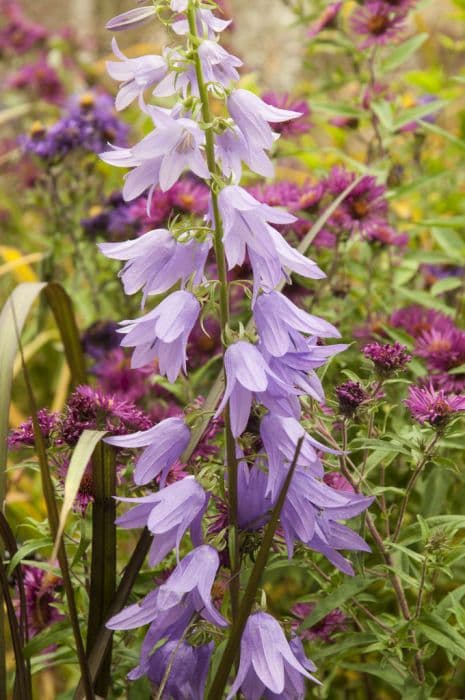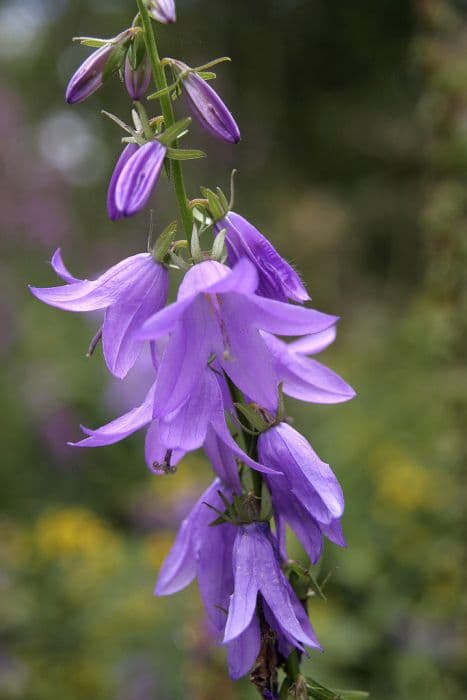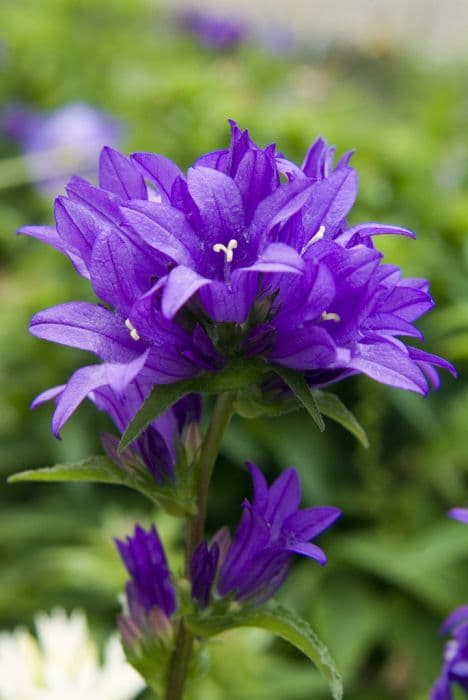Dalmatian Bellflower Campanula portenschlagiana 'Catharina'

ABOUT
Campanula portenschlagiana 'Catharina', commonly known as Dalmatian Bellflower, is a perennial plant that typically forms dense, low mounds covered in foliage and flowers. The leaves of this variety are deep green, heart-shaped to rounded, and have a somewhat glossy texture and toothed edges which add to their visual interest. Throughout its blooming period, 'Catharina' becomes a showcase of vibrant flowers. The blooms of the Dalmatian Bellflower 'Catharina' are particularly noteworthy for their shape and color. They are bell-shaped and face upward or outward, presenting a cheerful display. The flowers have a rich purple to violet hue, with a slightly lighter throat, which adds depth and contrast to their appearance. The blooms are borne on short stalks that rise above the foliage, creating a delightful carpet of color that can soften the edges of garden paths, rockeries, or container plantings. This cultivar is admired for its long blooming season and ability to attract pollinators to the garden while adding a burst of color to the planting area.
About this plant
 Names
NamesFamily
Campanulaceae.
Synonyms
Dalmatian Bellflower, Adria Bellflower, Wall Bellflower, Catarina.
Common names
Campanula muralis, Campanula portenschlagiana.
 Toxicity
ToxicityTo humans
The Dalmatian Bellflower is not known to be toxic to humans. However, as with any plant, individual allergic reactions or sensitivities could occur. Ingesting parts of the plant is not typically associated with poisoning, and there are no common symptoms related to poisoning from this plant because it is not considered poisonous.
To pets
The Dalmatian Bellflower is considered non-toxic to pets such as dogs and cats. There are no significant symptoms of poisoning associated with the ingestion of this plant by pets, as it is generally deemed safe. However, ingestion of any plant material may cause mild gastrointestinal upset due to irritation or an individual pet's sensitivity.
 Characteristics
CharacteristicsLife cycle
Perennials
Foliage type
Evergreen
Color of leaves
Green
Flower color
Blue
Height
1 foot (0.3 meters)
Spread
1.5 feet (0.45 meters)
Plant type
Herb
Hardiness zones
4
Native area
Dalmatia
Benefits
 General Benefits
General Benefits- Low maintenance: Campanula portenschlagiana 'Catharina' is known for being easy to care for, requiring minimal attention once established.
- Drought tolerance: Once established, it can tolerate periods of dryness, making it suitable for xeriscaping or gardens in arid climates.
- Aesthetic appeal: With its vibrant blue, bell-shaped flowers, it adds a splash of color and visual interest to gardens or landscapes.
- Attracts pollinators: The flowers are attractive to bees, butterflies, and other beneficial pollinators, which can help increase the health of your garden.
- Ground cover: It can effectively cover bare spots in the garden, helping to prevent soil erosion and suppress weed growth.
- Versatility: It's suitable for rock gardens, border fronts, hanging baskets, and containers due to its adaptable nature and cascading growth habit.
- Long blooming season: Its flowers typically bloom from late spring to early fall, providing extended color in the garden.
 Medical Properties
Medical PropertiesThis plant is not used for medical purposes.
 Air-purifying Qualities
Air-purifying QualitiesThis plant is not specifically known for air purifying qualities.
 Other Uses
Other Uses- Edible Decoration: The blooms of Dalmatian Bellflower can be used as edible garnishes on salads or desserts, providing a touch of color and a slight floral taste.
- Hair Accessory: The delicate flowers can be woven into braids or hair arrangements for outdoor events and weddings, adding a natural aesthetic.
- Bath Additives: Petals of Dalmatian Bellflower can be added to bathwater for a visually soothing experience.
- Natural Dye: The flowers of Dalmatian Bellflower can be used to produce a natural dye for fabrics or art projects.
- Garden Path Liner: By planting Dalmatian Bellflower along the edges of garden paths, they can create a beautiful, low-growing edge that guides visitors along the walkway.
- Candle Embedding: The flowers can be embedded into homemade candles to create a botanical look and gentle fragrance as they burn.
- Gift Decoration: Fresh or dried Dalmatian Bellflower blooms can be used to decorate gift wrappings, adding a personal touch to presents.
- Photography Prop: The plant can be used as a photography prop to add texture, depth, and color to close-up nature photographs.
- Table Centerpieces: Small pots of Dalmatian Bellflower can serve as living centerpieces for tables that require little maintenance and can be taken home by guests as favors.
- Floral Wreaths: Blooms and foliage can be interwoven into wreaths or garlands for decorating doors or tables at various festivities.
Interesting Facts
 Feng Shui
Feng ShuiThe Dalmatian Bellflower is not used in Feng Shui practice.
 Zodiac Sign Compitability
Zodiac Sign CompitabilityThe Dalmatian Bellflower is not used in astrology practice.
 Plant Symbolism
Plant Symbolism- Enduring Love: The bell-shaped flowers of the Dalmatian Bellflower, often associated with the idea of "constancy" and "everlasting love," signify a love that is persistent and resilient over time.
- Gratitude: The Dalmatian Bellflower is also a symbol of gratitude. It is often given as a gesture to thank someone for their consistent and unwavering support.
- Humility: The way the blooms hang down, similar to a bell, gives a sense of modesty and humility which this plant has come to represent.
 Water
WaterDalmatian Bellflowers should be watered regularly to keep the soil consistently moist but not soggy. An adequate approach would be to water them with approximately 1 inch of water once a week. During hotter seasons or in dry conditions, you might need to increase the frequency to twice a week. It's important to ensure the plant has good drainage to avoid root rot. Always check the top inch of the soil before watering; if it feels dry, it's time to water.
 Light
LightDalmatian Bellflowers thrive in a location that receives partial to full sunlight. They can tolerate some shade, but too much can limit blooms and cause leggy growth. Ideally, place them in a spot where they receive morning sunlight and are protected from the intense sun in the afternoon.
 Temperature
TemperatureDalmatian Bellflowers perform best in temperatures ranging from 50°F to 85°F. They can withstand a slight frost but prefer not to be in temperatures below 30°F. The ideal growing conditions would be in a temperate climate without extreme heat or cold.
 Pruning
PruningPruning Dalmatian Bellflowers is essential for promoting vigorous growth and abundant flowering. Deadhead spent flowers regularly to encourage new blooms. Cut back the foliage to the base in late fall or early spring to maintain a tidy appearance and stimulate new growth.
 Cleaning
CleaningAs needed
 Soil
SoilDalmatian Bellflower thrives in well-draining soil with a mix of peat, perlite, and compost. Aim for a slightly alkaline to neutral pH, around 7.0 to 7.5, for optimal growth. Regular feeding with a balanced fertilizer will help in lush flowering.
 Repotting
RepottingDalmatian Bellflower should be repotted every two to three years to replenish soil nutrients and to accommodate growth. Springtime is ideal for repotting, as the plant is emerging from dormancy and can recover quickly.
 Humidity & Misting
Humidity & MistingDalmatian Bellflower prefers moderate humidity but is adaptable to a wide range of indoor conditions. It does well with normal room humidity levels, without the need for any special adjustments.
 Suitable locations
Suitable locationsIndoor
Place in bright indirect light and water when top soil is dry.
Outdoor
Full sun to partial shade, shelter from harsh elements.
Hardiness zone
4-9 USDA
 Life cycle
Life cycleDalmatian bellflower 'Catharina' begins its life when seeds germinate, typically in spring, in well-draining soil with partial to full sun exposure. It develops into a small seedling, which then grows into a mat-forming perennial, characterized by its heart-shaped, dark green leaves. Throughout late spring to early summer, it enters its flowering stage, producing abundant, upward-facing, bell-shaped, violet-blue flowers. After pollination, the flowers develop into small capsule-like fruits that release seeds, ensuring the continuation of the plant's life cycle. Following the blooming period, the plant enters a phase of vegetative growth where it can focus on expanding its foliage and strengthening its root system. In winter, the Dalmatian bellflower 'Catharina' may die back, especially in colder climates, but it is generally hardy and will re-emerge from its rootstock with the return of warmer weather.
 Propogation
PropogationPropogation time
Spring to summer
Propogation: The Dalmatian bellflower, known botanically as Campanula portenschlagiana 'Catharina', is typically propagated in late spring to early summer. The most popular method of propagation is by division. To propagate by division, carefully unearth the parent plant and gently tease apart the root ball into several sections, ensuring that each new section has a portion of the root system. These individual divisions can then be replanted into well-draining soil, spacing them about 9 to 12 inches (approximately 23 to 30 centimeters) apart to allow for adequate growth. Water the new plantings thoroughly to help establish the young bellflowers in their new location.









